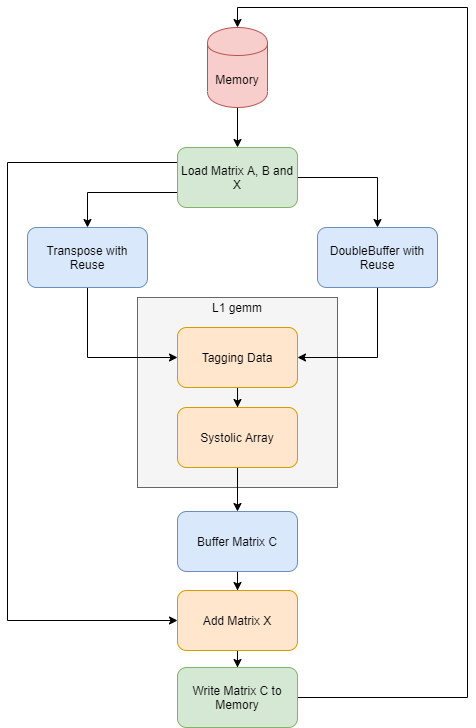GEMM Kernel¶
Architecture¶
GEMM kernel here is an implementation of the operation C = A * B + X, where A, B, X and C are matrices. This kernel is composed by three major parts, data movers, transpose and buffers, and a systolic array as shown in the figure below.

Systolic Array¶
The architecture of the systolic array is implemented with L1 primitive function gemm. The size of the systolic array is defined via template parameters. In this library, the size is set according the external memory datawidth. For single-precision floating point GEMM and 512-bit DDR interface, the systolic array size is 16 x 16.
Matrix Block Partition¶
There is no size limitations for matrices in the operation as long as they are fitted in the memory. The matrices are partitioned into multiple identical blocks for block matrix multiplication. The size of these matrix blocks should be multiple of the size of systolic array.
Data Movers¶
Data movers are responsible for data loading from the external memory to the computation unit and storing the results from the computation unit to the external memory. The original matrice are stored in its original row-major formats. They play an important role in the kernel to load and store the data with correct addresses due to the block matrix multiplication features.
Transpose¶
In the systolic array, the data of the matrix A (or B) should input in a transposed order compared to its original row-major format. Transpose unit in the GEMM kernel is implemented to perform the transpose operation. It also plays a role of double buffer and re-transmites the data to the systolic arrays since the data is re-usable in the block mattrix multiplication.
Double Buffers¶
For the other input matrix B (or A), its data needs to be also double buffered and can be reused. A special buffer object is designed to perform this operation in GEMM kernel.